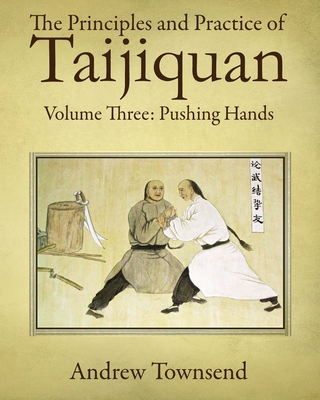The Principles and Practice of Taijiquan: Volume Three: Pushing Hands

The Principles and Practice of Taijiquan: Volume Three: Pushing Hands
This book constitutes the third installment of the five-volume series that is collectively titled The Principles and Practices of Taijiquan. Volume one deals with the principles and practices of taijiquan as related to the performance of the solo form, which many practitioners consider to be the primary activity of taijiquan. However, as a complete martial art, taijiquan includes a number other complementary practices and training methods, such as stretching, loosening, single-posture training, internal strength training, weapons training, and martial applications. A number of these ancillary training methods are addressed in the second volume of this series.This book, which is the third volume in the series, is relevant to all taijiquan aficionados who want to expand their practice to include pushing hands as an important aspect of the martial art of taijiquan. The dual-person training activities that are broadly referred to as "pushing hands," or tuishou in Mandarin, bridge the gap between the single-person practices such as the solo form, single-posture training, body conditioning, and internal strength training on the one hand and true martial applications on the other. As explained in this text, the practice of pushing hands was initially developed to train practitioners to apply the principles of taijiquan while interacting with another individual. As such, pushing hands is not intended to directly teach practitioners to employ taijiquan for fighting or self-defense. This is an important distinction and one which is clearly and repeatedly stated in this volume.What this volume does accomplish is to review the principles of taijiquan as they apply to the practice of pushing hands. The author takes the position that practitioners engaged in learning pushing hands must adhere to the principles of taijiquan as elucidated in the Taijiquan Classics as well as in the classical literature of taijiquan. The text employs copious references from the Classics as well as from such important texts such as Chen Kung's Discourses on Intrinsic Energy, the Yang Family Forty Chapters, Li Yaxuan's commentaries on pushing hands, and Chen Xin's Thirty-Six Pushing Hands Sicknesses in order to illustrate how to practice pushing hands according to the principles established by the founders and past masters of taijiquan. The book also includes the wisdom and experience of more contemporary authorities on taijiquan in general and pushing hands in particular, including insi
185.61Lei
185.61Lei
Indisponibil
Descrierea produsului
This book constitutes the third installment of the five-volume series that is collectively titled The Principles and Practices of Taijiquan. Volume one deals with the principles and practices of taijiquan as related to the performance of the solo form, which many practitioners consider to be the primary activity of taijiquan. However, as a complete martial art, taijiquan includes a number other complementary practices and training methods, such as stretching, loosening, single-posture training, internal strength training, weapons training, and martial applications. A number of these ancillary training methods are addressed in the second volume of this series.This book, which is the third volume in the series, is relevant to all taijiquan aficionados who want to expand their practice to include pushing hands as an important aspect of the martial art of taijiquan. The dual-person training activities that are broadly referred to as "pushing hands," or tuishou in Mandarin, bridge the gap between the single-person practices such as the solo form, single-posture training, body conditioning, and internal strength training on the one hand and true martial applications on the other. As explained in this text, the practice of pushing hands was initially developed to train practitioners to apply the principles of taijiquan while interacting with another individual. As such, pushing hands is not intended to directly teach practitioners to employ taijiquan for fighting or self-defense. This is an important distinction and one which is clearly and repeatedly stated in this volume.What this volume does accomplish is to review the principles of taijiquan as they apply to the practice of pushing hands. The author takes the position that practitioners engaged in learning pushing hands must adhere to the principles of taijiquan as elucidated in the Taijiquan Classics as well as in the classical literature of taijiquan. The text employs copious references from the Classics as well as from such important texts such as Chen Kung's Discourses on Intrinsic Energy, the Yang Family Forty Chapters, Li Yaxuan's commentaries on pushing hands, and Chen Xin's Thirty-Six Pushing Hands Sicknesses in order to illustrate how to practice pushing hands according to the principles established by the founders and past masters of taijiquan. The book also includes the wisdom and experience of more contemporary authorities on taijiquan in general and pushing hands in particular, including insi
Detaliile produsului










